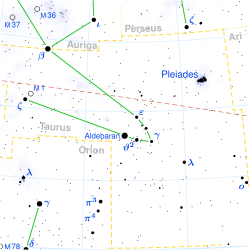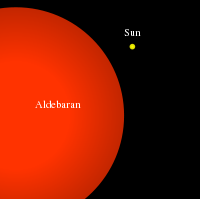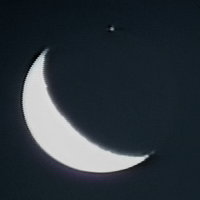Aldebaran
 The position of Aldebaran in the Taurus constellation. |
|
| Observation data Epoch J2000.0 Equinox J2000.0 |
|
|---|---|
| Constellation | Taurus |
| Right ascension | 04h 35m 55.239s[1] |
| Declination | +16° 30′ 33.49″[1] |
| Apparent magnitude (V) | 0.75-0.95[2] |
| Characteristics | |
| Spectral type | K5III[1] |
| U−B color index | 1.90 |
| B−V color index | 1.54 |
| Variable type | LB[2] |
| Astrometry | |
| Radial velocity (Rv) | +54.26 ±0.03[1] km/s |
| Proper motion (μ) | RA: 62.78 ±0.89[1] mas/yr Dec.: −189.35 ±0.58[1] mas/yr |
| Parallax (π) | 50.09 ± 0.95 mas |
| Distance | 65 ± 1 ly (20 ± 0.4 pc) |
| Absolute magnitude (MV) | −0.63 |
| Details | |
| Mass | 1.7[3] M☉ |
| Radius | 44.2[4] R☉ |
| Luminosity | 425[3] L☉ |
| Temperature | 4,010[3] K |
| Metallicity | 70% Sun[3] |
| Other designations | |
|
87 Tauri, Alpha Tauri, BD +16°629, GJ 171.1, GJ 9159, HD 29139, HIP 21421, HR 1457, SAO 94027
|
|
| Database references | |
| SIMBAD | data |
| ARICNS | data |
Aldebaran (α Tau, α Tauri, Alpha Tauri) is an orange giant star located about 65 light years away in the zodiac constellation of Taurus. With an average apparent magnitude of 0.87 it is the brightest star in the constellation and is one of the brightest stars in the nighttime sky. The name Aldebaran is Arabic (الدبران al-dabarān) and translates literally as "the follower", presumably because this bright star appears to follow the Pleiades, or Seven Sisters star cluster in the night sky. This star is also called the Bull's Eye because of its striking orange color and its location in the bull's head shaped asterism.[3]
In 1997 a substellar companion was reported but subsequent observations have not confirmed this claim.
Contents |
Physical properties

Aldebaran is classified as a type K5III star. It is an orange giant star that has moved off the main sequence line of the Hertzsprung–Russell diagram. It has exhausted the hydrogen fuel in its core and hydrogen fusion has ceased there. Although not yet hot enough for fusing helium, the core temperature of the star has greatly increased due to gravitational pressure and the star has expanded to a diameter of 44.2 times the diameter of the Sun,[4][5] approximately 61 million kilometres (see 10 gigametres for similar sizes). The Hipparcos satellite has measured it as 65.1 light-years (20.0 pc) away, and it shines with 150 times the Sun's luminosity.[3]
Aldebaran is a slightly variable star, of the "slow irregular variable" type LB. It varies by about 0.2 in apparent magnitude.[2]
Visibility
Aldebaran is one of the easiest stars to find in the night sky, partly due to its brightness and partly due to its spatial relation to one of the more noticeable asterisms in the sky. If one follows the three stars of Orion's belt from left to right (in the Northern Hemisphere) or right to left (in the Southern), the first bright star found by continuing that line is Aldebaran.
Aldebaran has the appearance of being the brightest member of the more scattered Hyades open star cluster that makes up the bull's head shaped asterism. However, Aldebaran is merely located by chance in the line of sight between the Earth and the Hyades, the star cluster is actually more than twice as far away, at about 150 light years.

Aldebaran is close enough to the ecliptic to be occulted by the Moon. Such occultations occur when the Moon's ascending node is near the autumnal equinox. This event will occur again around 2015. A reasonably accurate estimate for the diameter of Aldebaran was obtained during the September 22, 1978 occultation.[6]
Double star
Five faint stars appear close enough to Aldebaran in its visual field for astronomers to consider it a double star association. These stars were given alphabetic secondary star designations more or less in the order of their discovery, with the letter A reserved for the primary star. The better known characteristics of these optical double stars are listed in the table below with the primary star, Aldebaran (Alpha Tauri A), shown for reference.[7]
| Star α Tauri |
Right ascension |
Declination | Apparent magnitude |
Distance (light years) |
Proper motion (mas/yr) |
Spectral type |
Absolute magnitude |
Other names | References |
|---|---|---|---|---|---|---|---|---|---|
| A | 04h 35m 55.239s | +16° 30′ 33.49″ | 0.85 | 65 | RA: 62.78 ±0.89 Dec.: −189.35 ±0.58 |
K5III | −0.63 | Aldebaran, GJ 171.1 A, ADS 3321 A, BD +16°629A |
[1] |
| B | 04h 35m 57.0s | +16° 30′ 22″ | 13.6 | RA: 64 ±25 Dec.: -191 ±25 |
M2V | 11.98 | GJ 171.1 B | [8] | |
| C | 04h 35m 55.5s | +16° 30′ 38″ | 9.4 | ADS 3321 C | [9][10] | ||||
| D | 04h 35m 55.5s | +16° 30′ 38″ | 11.8 | ADS 3321 D | [9][11] | ||||
| E | 04h 35m 53.8s | +16° 31′ 08″ | BD +16°629E | [12] | |||||
| F | 04h 33.3m | +16° 22′ | 13.6 | BD +16°629F | [13] |
Some surveys have indicated that Alpha Tauri B may have about the same proper motion and parallax as Aldebaran and thus may be a physical binary system. However these measurements are difficult to make because the dim B component appears so close to the bright primary star. The resulting margin of error is too large to positively establish (or exclude) a physical relationship between the two stars. So far neither the B component, nor anything else, has been unambiguously shown to be physically associated with Aldebaran.[14]
Alpha Tauri CD is a binary system with the C and D component stars gravitationally bound to and co-orbiting each other. These co-orbiting stars have been shown to be located far beyond Aldebaran and are members of the Hyades star cluster. As with the rest of the stars in the cluster they do not physically interact with Aldebaran in any way.[9]
Claims of a planetary system
In 1993, radial velocity measurements of Aldebaran, Arcturus and Pollux showed that Aldebaran exhibited a long-period radial velocity oscillation, which could be interpreted as a substellar companion. The measurements for Aldebaran implied a companion with a minimum mass 11.4 times that of Jupiter in a 643-day orbit at a separation of 2.0 AU (300 Gm) in a mildly eccentric orbit. However, all three stars surveyed showed similar oscillations yielding similar companion masses, and the authors concluded that the variation was likely to be intrinsic to the star rather than due to the gravitational effect of a companion.[15] Subsequent observations have not confirmed any substellar companions in orbit around this star.[16]
Etymology
The name Aldebaran is the traditional Arabic (الدبران al-dabarān (ad-dabarān)) name which literally translates as "the follower". The name probably refers to the way this bright star follows the Pleiades star cluster in its nightly journey across the sky.[3]
In Persia it was known as Sadvis and Kugard.[17]
The Romans called it Palilicium.
In Chinese it is known as 畢宿五 (Bìxiùwŭ, the Fifth Star of the Net).
in Hindu astronomy it is identified as the lunar mansion Rohini and as one of the twenty-seven daughters of Daksha and the wife of the god Chandra.
Myths
This easily seen and striking star in its suggestive asterism is a popular subject for ancient and modern myths.
- Inuit culture In Inuit astronomy, Aldebaran is called "Spirit of a Polar Bear".
- Mexican culture For the Seris of northwestern Mexico, this star is providing light for the seven women giving birth (Pleiades). It has three different names: Hant Caalajc Ipápjö, Queeto, and Azoj Yeen oo Caap ("star that goes ahead"). The lunar month corresponding to October is called Queeto yaao "Aldebaran's path".[18]
- Native American culture For the Dakotas (a branch of the Native American Sioux tribe), Aldebaran took on a heroic aspect. The young star was the child of the sun and the lady Blue Star. One day, he desired to hunt the white buffalo (the Pleiades). After he pulled up a sapling to make a spear, a hole was made in the ground and he could see all the people of Earth down below. The white buffalo took this chance to push him through. He was found by an old woman and was to be known as Old Woman's Grandson. On Earth, he killed many strange monsters that had been troubling the Native Americans; one monster of which was a serpent that caused drought. The young hero killed the serpent, releasing a great stream of water that became the Mississippi River. In time, Old Woman's Grandson remembered the white buffalo and returned to hunting him in the sky to fulfill his destiny.
See also
- Aldebaran in fiction
- Aldebaran in astrology
- Iota Draconis
- Pollux
References
- ↑ 1.0 1.1 1.2 1.3 1.4 1.5 1.6 "V* alf Tau -- Variable Star". SIMBAD. Centre de Données astronomiques de Strasbourg. http://simbad.u-strasbg.fr/simbad/sim-id?Ident=HD+29139. Retrieved 2009-12-16.
- ↑ 2.0 2.1 2.2 "Query= alf Tau". General Catalogue of Variable Stars. Centre de Données astronomiques de Strasbourg. http://www.sai.msu.su/gcvs/cgi-bin/search.cgi?search=alf+Tau. Retrieved 2009-12-16.
- ↑ 3.0 3.1 3.2 3.3 3.4 3.5 3.6 James B. Kaler (May 22, 2009). "Aldebaran". Stars. http://stars.astro.illinois.edu/sow/aldebaran.html. Retrieved 2009-12-20.
- ↑ 4.0 4.1 Richichi, A.; Roccatagliata, V. (2005). "Aldebaran's angular diameter: How well do we know it?". Astronomy & Astrophysics 433 (1): 305–312. doi:10.1051/0004-6361:20041765. "We derive an average value of 19.96±0.03 milliarcsec for the uniform disk diameter. The corresponding limb-darkened value is 20.58±0.03 milliarcsec, or 44.2±0.9 R☉.".
- ↑ Richichi & Roccatagliata (2005) derived an angular diameter of 20.58±0.03 milliarcsec, which given a distance of 65 light years yields a diameter of 61 million km.
- ↑ White, N. M. (June, 1979). "Lunar occultation of the Hyades and diameters of Alpha Tauri and Theta-1 Tauri". The Astronomical Journal 84: 872–876. doi:10.1086/112489. Bibcode: 1979AJ.....84..872W.
- ↑ "VizieR Detailed Page CCDM===04359+1631". VizieR. Centre de Données astronomiques de Strasbourg. http://vizier.u-strasbg.fr/viz-bin/VizieR-S?CCDM%20J04359%2b1631E. Retrieved 2009-12-30.
- ↑ "GJ 171.1 B -- Star in double system". SIMBAD. Centre de Données astronomiques de Strasbourg. http://simbad.u-strasbg.fr/simbad/sim-id?Ident=CCDM+J04359%2B1631B. Retrieved 2009-12-30.
- ↑ 9.0 9.1 9.2 Griffin, R. F. (September, 1985). "Alpha Tauri CD - A well-known Hyades binary". Astronomical Society of the Pacific, Publications (ISSN 0004-6280) 97: 858–859. doi:10.1086/131616. Bibcode: 1985PASP...97..858G.
- ↑ "ADS 3321 C -- Star in double system". SIMBAD. Centre de Données astronomiques de Strasbourg. http://simbad.u-strasbg.fr/simbad/sim-id?Ident=ADS+3321+C. Retrieved 2009-12-30.
- ↑ "ADS 3321 D -- Star in double system". SIMBAD. Centre de Données astronomiques de Strasbourg. http://simbad.u-strasbg.fr/simbad/sim-id?Ident=ADS+3321+D. Retrieved 2009-12-30.
- ↑ "BD+16 629E -- Star in double system". SIMBAD. Centre de Données astronomiques de Strasbourg. http://simbad.u-strasbg.fr/simbad/sim-id?Ident=ADS+3321+E. Retrieved 2009-12-30.
- ↑ "BD+16 629F -- Star in double system". SIMBAD. Centre de Données astronomiques de Strasbourg. http://simbad.u-strasbg.fr/simbad/sim-id?Ident=ADS+3321+F. Retrieved 2009-12-30.
- ↑ Poveda, A.; Herrera, M. A.; Allen, C.; Cordero, G.; Lavalley, C. (April 1994). "Statistical studies of visual double and multiple stars. II. A catalogue of nearby wide binary and multiple systems". Revista Mexicana de Astronomia y Astrofisica 28 (1): 43–89. Bibcode: 1994RMxAA..28...43P.
- ↑ Hatzes, A., Cochran, W. (1993). "Long-period radial velocity variations in three K giants". The Astrophysical Journal 413 (1): 339 – 348. doi:10.1086/173002. http://adsabs.harvard.edu/cgi-bin/nph-bib_query?bibcode=1993ApJ...413..339H&db_key=AST&high=3c0dab1fe513529.
- ↑ Hatzes, A., Cochran, W. (1998). "On the nature of the radial velocity variability of Aldebaran - A search for spectral line bisector variations". Monthly Notices of the Royal Astronomical Society 293: 469 – 478. doi:10.1046/j.1365-8711.1998.01186.x. http://adsabs.harvard.edu/cgi-bin/nph-bib_query?bibcode=1998MNRAS.293..469H&db_key=AST&high=3769fd414921247.
- ↑ Lughatnama-yi Dehkhuda, under Dabaran.
- ↑ Moser, Mary B.; Stephen A. Marlett (2005) (in Spanish and English) (PDF). Comcáac quih yaza quih hant ihíip hac: Diccionario seri-español-inglés. Hermosillo, Sonora and Mexico City: Universidad de Sonora and Plaza y Valdés Editores. http://lengamer.org/admin/language_folders/seri/user_uploaded_files/links/File/DiccionarioSeri2005.pdf.
External links
- "Aldebaran 2". SolStation. http://www.solstation.com/stars2/aldebaran.htm. Retrieved 2005-11-14.
Coordinates: ![]() 04h 35m 55.2s, +16° 30′ 33″
04h 35m 55.2s, +16° 30′ 33″
|
||||||||||||||||||||||||||||||||||||||||||||||||||||||||||||||||||||||||||||||||||||||||||||||||||||||||||||||||||||||||||||||||||||||||||||||||||||||||||||||||||||||||||||||||||||||||||||||||||||||||||||||||||||||||||||||||||||||||||||||||||||||||||||||||||
|
|||||||||||||||||